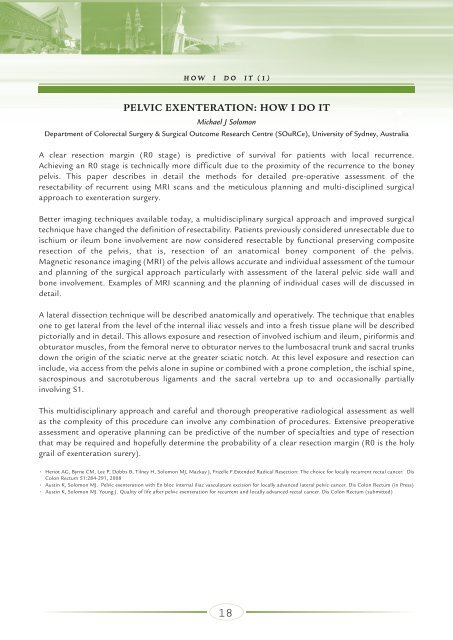here - Malaysian Society of Colorectal Surgeons
here - Malaysian Society of Colorectal Surgeons
here - Malaysian Society of Colorectal Surgeons
Create successful ePaper yourself
Turn your PDF publications into a flip-book with our unique Google optimized e-Paper software.
H O W I D O I T ( 1 )PELVIC EXENTERATION: HOW I DO ITMichael J SolomonDepartment <strong>of</strong> <strong>Colorectal</strong> Surgery & Surgical Outcome Research Centre (SOuRCe), University <strong>of</strong> Sydney, AustraliaA clear resection margin (R0 stage) is predictive <strong>of</strong> survival for patients with local recurrence.Achieving an R0 stage is technically more difficult due to the proximity <strong>of</strong> the recurrence to the boneypelvis. This paper describes in detail the methods for detailed pre-operative assessment <strong>of</strong> t<strong>here</strong>sectability <strong>of</strong> recurrent using MRI scans and the meticulous planning and multi-disciplined surgicalapproach to exenteration surgery.Better imaging techniques available today, a multidisciplinary surgical approach and improved surgicaltechnique have changed the definition <strong>of</strong> resectability. Patients previously considered unresectable due toischium or ileum bone involvement are now considered resectable by functional preserving compositeresection <strong>of</strong> the pelvis, that is, resection <strong>of</strong> an anatomical boney component <strong>of</strong> the pelvis.Magnetic resonance imaging (MRI) <strong>of</strong> the pelvis allows accurate and individual assessment <strong>of</strong> the tumourand planning <strong>of</strong> the surgical approach particularly with assessment <strong>of</strong> the lateral pelvic side wall andbone involvement. Examples <strong>of</strong> MRI scanning and the planning <strong>of</strong> individual cases will de discussed indetail.A lateral dissection technique will be described anatomically and operatively. The technique that enablesone to get lateral from the level <strong>of</strong> the internal iliac vessels and into a fresh tissue plane will be describedpictorially and in detail. This allows exposure and resection <strong>of</strong> involved ischium and ileum, piriformis andobturator muscles, from the femoral nerve to obturator nerves to the lumbosacral trunk and sacral trunksdown the origin <strong>of</strong> the sciatic nerve at the greater sciatic notch. At this level exposure and resection caninclude, via access from the pelvis alone in supine or combined with a prone completion, the ischial spine,sacrospinous and sacrotuberous ligaments and the sacral vertebra up to and occasionally partiallyinvolving S1.This multidisciplinary approach and careful and thorough preoperative radiological assessment as wellas the complexity <strong>of</strong> this procedure can involve any combination <strong>of</strong> procedures. Extensive preoperativeassessment and operative planning can be predictive <strong>of</strong> the number <strong>of</strong> specialties and type <strong>of</strong> resectionthat may be required and hopefully determine the probability <strong>of</strong> a clear resection margin (R0 is the holygrail <strong>of</strong> exenteration surery).• Heriot AG, Byrne CM, Lee P, Dobbs B, Tilney H, Solomon MJ, Mackay J, Frizelle F.Extended Radical Resection: The choice for locally recurrent rectal cancer. DisColon Rectum 51:284-291, 2008• Austin K, Solomon MJ. Pelvic exenteration with En bloc internal iliac vasculature excision for locally advanced lateral pelvic cancer. Dis Colon Rectum (in Press)• Austin K, Solomon MJ. Young J. Quality <strong>of</strong> life after pelvic exenteration for recurrent and locally advanced rectal cancer. Dis Colon Rectum (submitted)18










